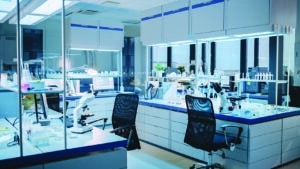
Long standing limits on lab construction in Brookline could be lifted in 2022 as officials review rezoning for properties along Route 9. But the town faces stiff competition from nearby development clusters in Boston and Route 128 suburbs that are aggressively courting the life science industry.
Brookline officials want to position the town’s commercial districts for life science development by removing long standing barriers to lab space.
The Route 9 corridor is viewed as the obvious landing spot for biotech growth. A medical office property owned by Bulfinch Cos. at 10 Brookline Place is being studied for redevelopment, and town officials are launching a larger study of the corridor that could make parcels including Chestnut Hill Office Park more attractive for lab uses.
“Locationally, Brookline has everything going for it,” said Duncan Gratton, executive director for Cushman & Wakefield in Boston. “It’s proximate to the Longwood Medical Area and what’s going on in the Fenway [with life science development], and it has Green Line access.”
The Brookline Village neighborhood near Boston’s Longwood Medical Area and its acclaimed hospital cluster is an obvious magnet for life science researchers, according to officials and commercial real estate executives.
But Brookline has just one parcel that’s currently approved for life science uses. Town meeting approved lab zoning for Boston Children’s Hospital at 2 Brookline Place in 2004, but the hospital opted to build medical offices instead.
Route 9 Parcels Eyed
More recently, two potential redevelopment sites owned by Bulfinch Cos. and WS Development have come into focus. After a nine-month study, Brookline’s Economic Development Advisory Committee identified 10 Brookline Place and the Chestnut Hill Office Park as properties likely to attract life science projects.
The Bulfinch Cos.-owned 10 Brookline Place contains a 107,000-square-foot office building on 1.7 acres next to the MBTA Green Line’s Brookline Village stop. The Brookline Select Board recently appointed a committee to meet with Bulfinch executives to discuss parameters of rezoning the property, with a goal of bringing a proposal to Town Meeting in fall 2022.
“Given Brookline Village’s proximity to the LMA, we feel that there are some market opportunities,” said Paul Saner, co-chair of the Brookline Economic Development Advisory Committee. “And obviously Bulfinch Cos. feels the same way.”
Bulfinch did not respond to requests for comment.
In a longer-term process, officials are studying redevelopment prospects for the “Chestnut Hill West” district located on the south side of Route 9 between Hammond Street and Hammond Pond Parkway.
The district includes the 5-acre Chestnut Hill Office Park, which contains four office buildings and is owned by Newton-based WS Development. Officials expect to recommend new lab-friendly zoning for the entire district, but the process is not expected to be complete until 2023 at the earliest, Saner said.
Amid concerns about safety of lab facilities, the committee is not recommending the approval of Biosafety Level 3 or 4 facilities, which engage in research of serious infectious diseases, as defined by the Centers for Disease Control and Prevention. The town also plans to add new health and safety regulations to be administered by its Department of Public Health.
Town Plays Catch-up Amid 10M SF Pipeline
Brookline’s process comes in the wake of Newton’s adoption this year of life science zoning for Mark Development’s Riverside redevelopment, including 362,000 square feet of office-lab space. Brookline also faces competition from Route 128 suburbs that are aggressively recruiting life science development.
“People take the path of least resistance. Our locational benefits will not be sufficient,” said Cliff Brown, an Economic Development Advisory Committee member, in a presentation to the Select Board last month.
Burlington and Lexington both are promoting fast-track life science permitting. Burlington’s new “Innovation District” which spans nearly 150 acres off Route 128 includes life science as a by-right use. Lexington is offering 60-day-or-less approvals for lab projects in its new 260-acre Hartwell Innovation Park district. By contrast, Brookline is considering a more rigorous special permit process for lab proposals.
Another limiting factor for Brookline is timing. Greater Boston developers’ massive lab construction pipeline seeks to address the gap between biotech demand and the current inventory.

Steve Adams
There are currently 10 million square feet of lab construction and conversion projects under way in Greater Boston, all of which is scheduled for completion by the end of 2022, according to research released last week by CBRE. But life science companies’ space requirements total just 6 million square feet, indicating that supply could catch up with demand before any new projects could be completed in Brookline. Developers interviewed by the Brookline Economic Development Advisory Committee stated that they are unlikely to commit to transactions until the new zoning and health regulations are approved.
“Burlington and Lexington are more pro-development than some of the more urban locations,” Cushman & Wakefield’s Gratton said. “So, anything you do to create uncertainty isn’t going to help. These companies are all focused on speed, and they’re not like a downtown Boston office tenant looking three years ahead of their lease expiration.”
One factor that could help prospects for future Brookline developments is the preference of tenants for new product, said Jeff Myers, research director at Colliers International in Boston. New class A lab buildings have the lowest vacancy rate throughout Greater Boston at under 1 percent, according to Colliers research.
“Those sites are few and far between. Brookline is not historically a major commercial real estate market, so they’re a little bit behind in that regard, but they’re acknowledging that and positioning themselves to allow developers to move forward on a smoother path,” he said.




 |
| 